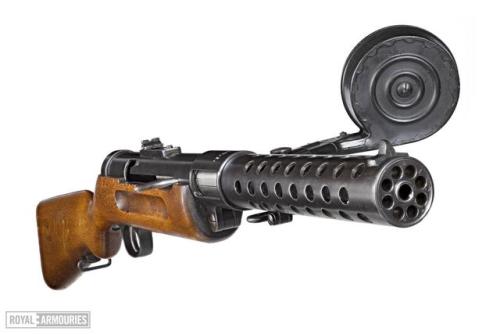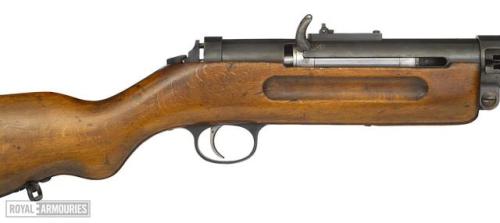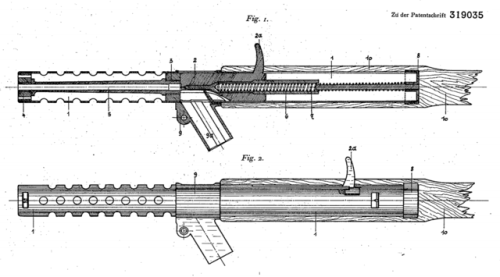historicalfirearms:Bergmann MP18,IBy 1915, the Imperial German Army had begun developing infiltratio
historicalfirearms:Bergmann MP18,IBy 1915, the Imperial German Army had begun developing infiltration tactics to overcome the stalemate of the Western Front. The formation of dedicated, specialist Sturmtruppen units in 1915-16 saw the army call for new light weapons suitable for the rapid assaults and close quarter fighting that Sturmtruppen found themselves engaged in. The German Army asked the Gewehr-Prüfungs-Kommission (GPK) to begin a programme to select a new lightweight, fully automatic assault weapon. The weapon, chambered in 9x19mm, would later come to be commonly known as the submachine gun. A number of manufacturers developed and submitted designs including Mauser, Rhinemetall, Walther, Bergmann and Schwarzlose. The GPK’s specification called for a fully automatic weapon that fired from closed-bolt. Despite firing from an open bolt, using a blowback action, the Bergmann MP18,I’s simplicity impressed the GPK and the army adopted the Bergmann at the end of 1917, ordering 50,000. The MP18,I was first issued in 1918, seeing action during the 1918 Spring Offensive. MP18,I with a Trommelmagazin, without an over insertion sleeve (source)Designed by a team lead by Hugo Schmeisser at Bergmann Industriewerke, the MP18,I became the basis for a whole family of submachine guns. Initial prototypes fed from a box magazine, however, it seems that this was changed to the 32-round Trommelmagazin, which had entered production in late 1916. This suffered from feed issues in the mud of the western front. The ‘snail drums’ were also tedious to load and not an ideal shape for carrying. The MP18,I’s magazine housing was angled at 60 degrees to enable proper feeding. The housing, however, is shorter than a Luger P08′s grip and a special sleeve had to be issued to prevent over insertion which could lead to jams and damage to the feed lips.Schmeisser’s design was protected by two patents filed in 1917 and early 1918, however, they were placed under the owner of the company, Theodor Bergmann’s name. The MP18,I used a blowback action with a simple trigger mechanism. Its only safety was a safety notch marked ‘S’ into which the retracted bolt could be placed. Schmeisser patented this under his own name in 1920, after he left Bergmann Wekre. These were features that continued to be seen in subsequent submachine guns for decades to come. Stormtrooper with an MP18,I (source)The second patent covered the weapon’s hinged receiver design, which allowed it to be easily disassembled, with the disassembly catch at the rear of the receiver tube. The weapon had a 20cm (8 inch) barrel inside a perforated barrel jacket for cooling and a simple tangent rear sight. The MP18,I’s rate of fire was relatively slow at ~450 rounds per minute and despite not having a select fire capability an experienced user could fire single shots. While handy, with an overall length of 81.3cm (32 inches), the MP18,I was heavy weighing 4.17kg (9lb 3oz). When the MP18,I was first issued to Sturmtruppen, each submachine gunner was assigned one or two ammunition bearers, although sources suggest ammunition carriers were not always necessary. Combined with hand grenades, pistol carbines, light machine guns like the MG15nA and the MG08/15 and handy carbines like the K98a the Sturmtruppen were extremely well equipped. While these new units made remarkable progress during the Spring Offensive, Germany was unable to maintain the momentum and by the end of the year the Army on the Western Front had collapsed and an armistice was signed. By the end of World War One only 17,677 MP18,Is of the 50,000 ordered had been delivered. Despite this the MP18,I began a long line of submachine guns which were developed throughout the interwar period including the MP28,II as well as copies such as the British Lanchester and the Spanish Modelo 1929. Schmeisser’s MP18,I remained in service with German police for decades and influenced many of the submachine gun designs that followed it. Sources:Images: 1 2 3 4 5 6The Schmeisser Myth - German Submachine Guns Through Two World Wars, M. Helebrant (2016)‘Maschinenpistole mit Traegheitsverschluss’, T Bergmann, German Patent #319035, 16/12/1920, (source)‘Maschinenpistole mit Traegheitsverschluss’, T. Bergmann, German Patent #334450, 16/03/1921, (source)‘Sicherung an selbsttaetigen Feuerwaffen‘, H. Schmeisser, German Patent #351621, 29/031922, (source)If you enjoy the content please consider supporting Historical Firearms through Patreon! -- source link
Tumblr Blog : www.historicalfirearms.info





